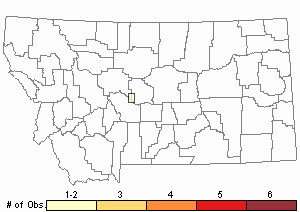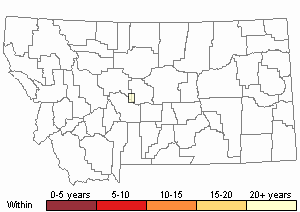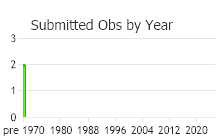View in other NatureServe Network Field Guides
NatureServe
Montana
Utah
Wyoming
Idaho
Wisconsin
British Columbia
South Carolina
Yukon
California
New York
A Cynodontium Moss - Cynodontium tenellum
General Description
Plants: Acrocarpous, growing in tufts, with many rhizoids below (Lawton 1971). Stems upright, (0.5)1-2(-3) cm (FNA 2007).
Leaves: Curled and contorted when dry, upright-spreading when wet (Lawton 1971), narrowly-lanceolate, 2-3(-3.5) mm; apex essentially acute; margin lightly curved under for a portion of the leaf or occasionally almost flat, 2(-3)-layered (FNA 2007), finely toothed near apex (Lawton 1971); costa single, smooth proximally, or sometimes toothed abaxially in the apical end from protruding cell ends, guide cells occurring in one row in x-section (FNA 2007).
Leaf Cells: Laminal cells with small bumps (papillae) well-dispersed or smooth; basal cells long-rectangular, about 5:1; alar region faintly differentiated if at all; medial and distal laminal cells short and rectangular, plumply quadrate, or irregular, usually 2:1, wider and longer near costa (FNA 2007), the median cells from almost smooth to papillose (Lawton 1971).
Phenology
Capsules ripen in summer (FNA 2007).
Diagnostic Characteristics
Some authors regard Cynodontium alpestre to be a variant of C. tenellum; the distribution of neither species in the United States is well understood (FNA 2007).
Range Comments
Greenland; Canada: AB, BC, MB, NL, NT, NS, NU, ON, QC, SK, YT; USA: AK, ME, MN, MT, SD; Eurasia; Atlantic Islands (Iceland) (FNA 2007). In Montana: Beaverhead and Cascade Counties (Elliott 2016).
Observations in Montana Natural Heritage Program Database
Number of Observations: 2
(Click on the following maps and charts to see full sized version)
Map Help and Descriptions
Relative Density

Recency


 (Observations spanning multiple months or years are excluded from time charts)
(Observations spanning multiple months or years are excluded from time charts)
Habitat
Rocks and crevices (Elliott 2016).
Reproductive Characteristics
Autoicous; the perigonia stalkless (FNA 2007). Seta straight whether dry or moist, (5)6-7(-10) mm in height. Capsule upright and straight, hood-like, lacking any swelling at the base (FNA 2007).
References
- Literature Cited AboveLegend:
 View Online Publication
View Online Publication Elliott, J.C. and A.K. Pipp. 2018. A Checklist of Montana Mosses (1880-2018). Updated 3 January, 2020. Montana Natural Heritage Program, Helena, Montana. 73 pp.
Elliott, J.C. and A.K. Pipp. 2018. A Checklist of Montana Mosses (1880-2018). Updated 3 January, 2020. Montana Natural Heritage Program, Helena, Montana. 73 pp. Flora of North America Editorial Committee, eds. 2007. Flora of North America North of Mexico. Volume 27. Bryophytes: Mosses, Part 1. Oxford University Press, Inc., NY. xxi + 713 pp.
Flora of North America Editorial Committee, eds. 2007. Flora of North America North of Mexico. Volume 27. Bryophytes: Mosses, Part 1. Oxford University Press, Inc., NY. xxi + 713 pp. Lawton, E. 1971. Moss Flora of the Pacific Northwest. Hattori Botanical Laboratory. Japan: Yamabuki-cho, Shinjuku-ku, Tokyo. 362 pages plus appendices.
Lawton, E. 1971. Moss Flora of the Pacific Northwest. Hattori Botanical Laboratory. Japan: Yamabuki-cho, Shinjuku-ku, Tokyo. 362 pages plus appendices.
- Additional ReferencesLegend:
 View Online Publication
View Online Publication
Do you know of a citation we're missing? Elliot, J. C. 1993. Second checklist of Montana mosses. Unpublished report. U.S. Forest Service, Region 1. Missoula, MT. 45 pp.
Elliot, J. C. 1993. Second checklist of Montana mosses. Unpublished report. U.S. Forest Service, Region 1. Missoula, MT. 45 pp. Lawton, E. 1971. Keys for the Identification of the Mosses on the Pacific Northwest. Reprinted from 'Moss Flora of the Pacific Northwest'. Published as Supplement No. 2 of the Journal of the Hattori Botanical Laboratory. Nichinan, Miyazaki, Japan. 66 pp.
Lawton, E. 1971. Keys for the Identification of the Mosses on the Pacific Northwest. Reprinted from 'Moss Flora of the Pacific Northwest'. Published as Supplement No. 2 of the Journal of the Hattori Botanical Laboratory. Nichinan, Miyazaki, Japan. 66 pp.
- Web Search Engines for Articles on "A Cynodontium Moss"





